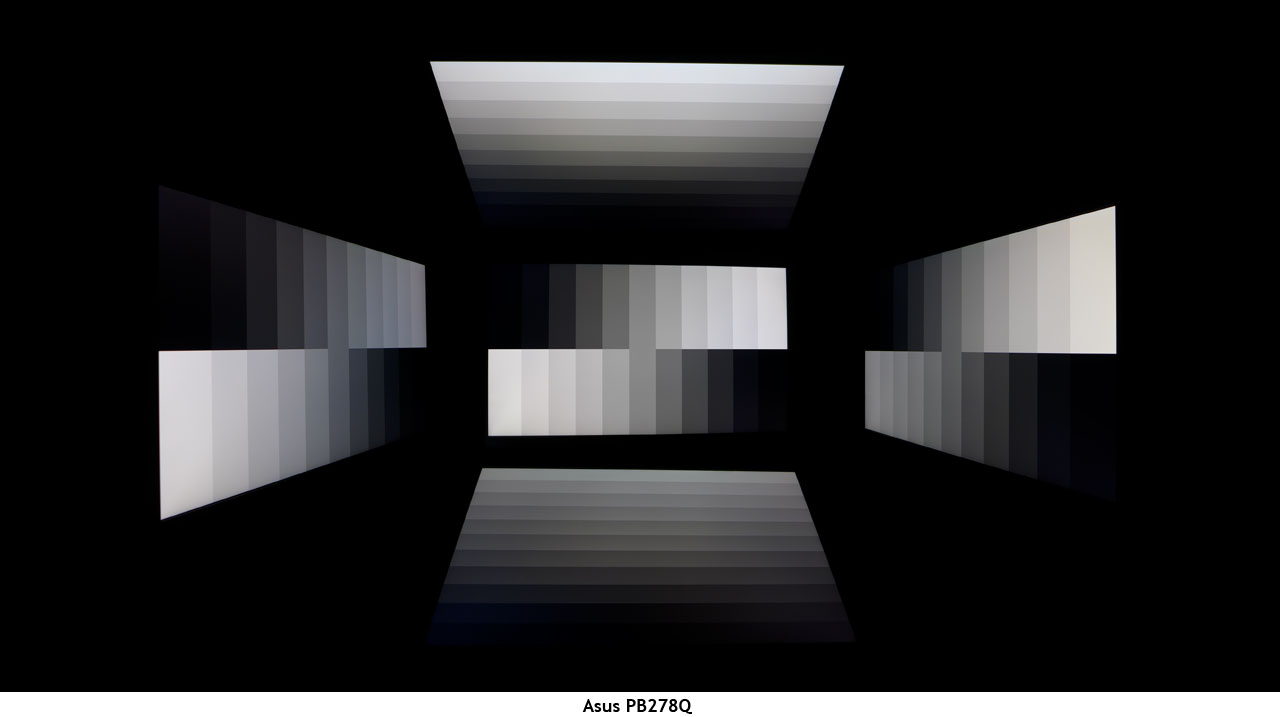HP ZR2740w Versus Asus PB278Q: QHD 27" Monitors, Tested
Until cutting-edge UHD (3840\00d72160) displays hit the mainstream, most enthusiasts have to be content with QHD monitors at 2560x1440 pixels. In the lab today, we have two more 27-inch QHD screens: the ZR2740w from HP and the PB278Q from Asus.
Results: Viewing Angle And Uniformity
For off-axis viewing, there’s no better tech right now than IPS. You can sit as much as 45 degrees from center and still see a decent image. The light falloff is minimal, and the color shift associated with TN monitors is virtually non-existent.
Since the ZR2740w utilizes the LG H-IPS panel as its core, great off-axis performance is expected, and our photo shows that it doesn’t disappoint. Now that we’re showing step patterns, it’s easier to see when detail and light output are reduced as you move off-center. The HP maintains detail at the lowest and highest brightness levels with no perceptible color shift.
Here’s the Asus PB278Q:
Predictably, the Asus looks very similar in its viewing angle photo. Since the base panel is the same as Samsung’s excellent PLS monitor, the S27B970D, you can expect the same top-notch off-axis performance from the PB278Q. Once again, IPS proves itself to be the best currently-available technology for off-center viewing.
While some monitors are better than others, no LCD panel has perfect screen uniformity, and even samples of the same model can have quite a bit of variation. So, since there’s no fair standard for applying a rating to different monitors, we’ll simply present the results of our measurements.
To measure screen uniformity, zero percent and 100 percent full-field patterns are used, and nine points are sampled. We’re now expressing the values as percentages relative to the center of the screen.
| HP ZR2740w | ||
|---|---|---|
| Black Field Uniformity | ||
| 99.01% | 112.49% | 106.18% |
| 101.25% | 100.00% | 102.83% |
| 78.37% | 80.67% | 117.75% |
| White Field Uniformity | ||
| 91.05% | 94.26% | 87.93% |
| 93.96% | 100.00% | 91.67% |
| 95.81% | 95.45% | 101.80% |
Except for a slight hotspot at the lower-right corner, the ZR2740w does pretty well for black field uniformity. Its white field uniformity is even better with no visible variation except for a slightly dim upper-right corner.
Get Tom's Hardware's best news and in-depth reviews, straight to your inbox.
The PB278Q, meanwhile, doesn’t fare quite as well.
| Asus PB278Q | ||
|---|---|---|
| Black Field Uniformity | ||
| 91.90% | 94.29% | 83.28% |
| 63.03% | 100.00% | 74.30% |
| 142.99% | 101.87% | 110.49% |
| White Field Uniformity | ||
| 89.71% | 98.56% | 91.19% |
| 83.58% | 100.00% | 86.75% |
| 90.74% | 95.35% | 97.55% |
In a full black field pattern, there is a visible bright area across the bottom of the screen. Thankfully, this doesn’t translate to the white field pattern, which looks quite good to the naked eye.
Current page: Results: Viewing Angle And Uniformity
Prev Page Results: Color Gamut And Performance Next Page Results: Pixel Response And Input Lag
Christian Eberle is a Contributing Editor for Tom's Hardware US. He's a veteran reviewer of A/V equipment, specializing in monitors. Christian began his obsession with tech when he built his first PC in 1991, a 286 running DOS 3.0 at a blazing 12MHz. In 2006, he undertook training from the Imaging Science Foundation in video calibration and testing and thus started a passion for precise imaging that persists to this day. He is also a professional musician with a degree from the New England Conservatory as a classical bassoonist which he used to good effect as a performer with the West Point Army Band from 1987 to 2013. He enjoys watching movies and listening to high-end audio in his custom-built home theater and can be seen riding trails near his home on a race-ready ICE VTX recumbent trike. Christian enjoys the endless summer in Florida where he lives with his wife and Chihuahua and plays with orchestras around the state.

